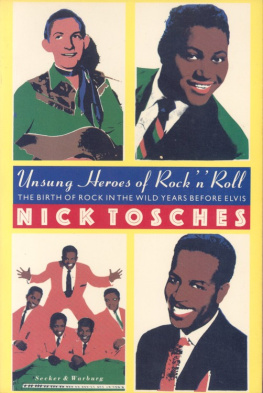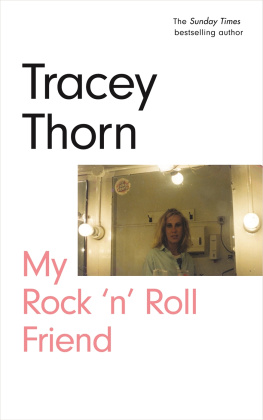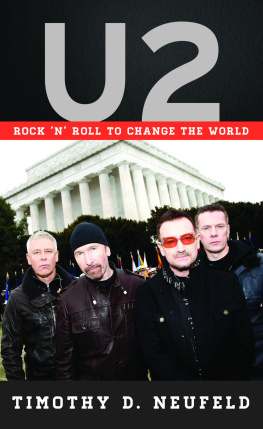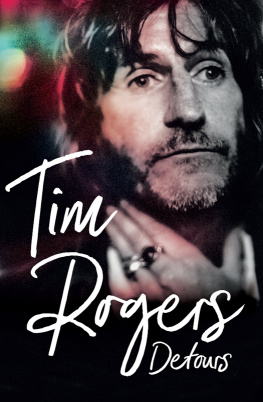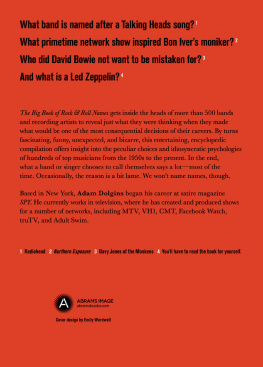ROUTLEDGE LIBRARY EDITIONS: POPULAR MUSIC
Volume 8
ROCK N ROLL
First published in 1982 by Routledge & Kegan Paul Ltd
This edition first published in 2016
by Routledge
2 Park Square, Milton Park, Abingdon, Oxon OX14 4RN
and by Routledge
711 Third Avenue, New York, NY 10017
Routledge is an imprint of the Taylor & Francis Group, an informa business
1982 Dave Rogers
All rights reserved. No part of this book may be reprinted or reproduced or utilised in any form or by any electronic, mechanical, or other means, now known or hereafter invented, including photocopying and recording, or in any information storage or retrieval system, without permission in writing from the publishers.
Trademark notice: Product or corporate names may be trademarks or registered trademarks, and are used only for identification and explanation without intent to infringe.
British Library Cataloguing in Publication Data
A catalogue record for this book is available from the British Library
ISBN: 978-1-138-19432-8 (Set)
ISBN: 978-1-315-62255-2 (Set) (ebk)
ISBN: 978-1-138-64975-0 (Volume 8) (hbk)
ISBN: 978-1-315-62400-6 (Volume 8) (ebk)
Publishers Note
The publisher has gone to great lengths to ensure the quality of this reprint but points out that some imperfections in the original copies may be apparent.
Disclaimer
The publisher has made every effort to trace copyright holders and would welcome correspondence from those they have been unable to trace.
Rock n Roll
Dave Rogers
First published in 1982
by Routledge & Kegan Paul Ltd
39 Store Street, London WC1E 7DD,
9 Park Street, Boston, Mass. 02108, USA,
296 Beaconsfield Parade, Middle Park,
Melbourne, 3206, Australia and
Broadway House, Newtown Road,
Henley-on-Thames, Oxon RG9 1EN
Set in 11 on 14pt Helvetica by
Input Typesetting Ltd, London
and printed in Great Britain by
St Edmundsbury Press, Bury St Edmunds, Suffolk
Dave Rogers 1982
No part of this book may be reproduced in
any form without permission from the
publisher, except for the quotation of brief
passages in criticism
ISBN 0 7100 0938 0
To all the rocknroll artists Ive not had the space to mention, and, particularly, to Carl Perkins, and to Gene Vincent
I was very lucky. The people were looking for something different and I came along just in time
Elvis Presley
You know my temperatures risin,
The juke-boxs blowin a fuse,
My hearts beatin rhythm,
My soul keeps a-singin the blues
Roll over Beethoven,
Tell Tchaikovsky the news ..
Chuck Berry
Contents
I love those dear hearts and gentle people
That live in my home town
I know those dear hearts and gentle people
Will never ever let me down
Dinah Shore, 1950
Before rocknroll, that song seemed to sum up what pop music was all about. It was certainly tuneful, but mostly it was sentimental music for adults to feel at home with. Of course there were childrens songs, like Rudolph The Red-Nosed Reindeer and How Much Is That Doggie In The Window? But if you were a teenager leaving school, earning money for the first time, and wanting to go out and spend it on enjoying yourself, there was no music which you could really call your own. The Top Twenty was full of slow ballads, string orchestras and sing-along novelty songs like Where Will The Dimple Be? and I See The Moon (the moon sees me was the next line!).
Excitement? There wasnt a lot. In America, singing idols Guy Mitchell and Frankie Laine looked old enough to be your father. In Britain, Dickie Valentine and Lita Roza were part of large dance bands. It was all much too predictable and polished. There was hardly a guitar in sight.
Johnnie Ray, too, was an early 1950s heart-throb, but he was a little different. In 1952 his record Cry topped the charts. Like most of his songs, it was full of emotion you could hear his voice break with misery. On stage he would fall to his knees and cry real tears. His nicknames were Prince of Wails and Cry Guy! He was tall and thin, and an accident when he was ten had left him half-deaf. But he didnt try to hide his deaf-aid as other stars might have done. It turned out to be an asset for it added to the emotion and his fans loved him all the more.
He was a star right up to the arrival of Elvis Presley. At first the two were compared, for though their music was quite different they did have one thing in common: they both felt what they were singing about. Earlier pop singers, like Perry Como, had been almost polite, crooning songs without showing too much involvement. Ray was the first million-selling pop singer to get inside his songs and put his own emotions on show. The singer was becoming more important than the song, and the image greater than the singer.
In the early 1950s the first music with some guts to catch on in Britain was piano-boogie: music with a bouncing beat and a non-stop rolling rhythm from the left hand playing the bass notes at a fast eight beats to the bar. Tennessee Ernie Ford had a hit with Shotgun Boogie, but it was Merrill E. Moore from California whose records sounded best. It wasnt yet rocknroll, but it was certainly news for dancin feet. It was strong, lively and loud, and a long way from the slushy orchestras and cumbersome big bands down at the local dance-hall.
In Britain, Moores music appealed most to one particular group of young people: In 53/54 his Bell Bottom Boogie/House Of Blue Lights was a hot favourite with the first generation of London Teddy Boys.
Kids came back from evacuation to find their home surroundings in ruins, especially in London which was hit worst of all. In many cases their fathers were still away from home clearing up the last remnants of the war, and consequently the kids were able to do almost as they liked. Street gangs sprang up as a substitute for home life.
Tennessee Teddy
By the 1950s, the clothes the gang-members wore were an up-dated copy of mens fashion in the reign of King Edward VII before the First World War. Originally the new extravagant style was meant for rich young men-about-town. But, although it was expensive, the working-class youths of south London began to wear it and adapt it tightly fitting trousers (drainpipes), fancy waistcoats, and a long, drape jacket which had sleeves that reached over the fingertips, and velvet on the turned-back cuffs and round the back of the collar. At first the newspapers called them Edwardian youths, but soon came the more popular label, Teddy boys.
Added to the basic suit later came thick crepe-soled shoes brothel-creepers. Round the neck, over a sometimes black shirt, they wore a thin, straight tie or a bootlace like one of the black-jacketed, cheroot-smoking baddies you saw in cowboy films dealing cards off the bottom of the pack and shooting anyone who dared call him a cheat.
And that was the image that went with the style. Sullen, mean and dangerous-looking, it owed a lot to westerns and gangster films. It was topped off with the most outlandish hair-styles: long and heavily greased, combed back round each side ending in a DA (meaning ducks arse because thats what it looked like from the back!). At the front it was piled up and back, or fell forward over the forehead in an elephants trunk. There was even a vogue for Mohican cuts: shaved on both sides leaving a wide strip of crewcut hair from front to back.






